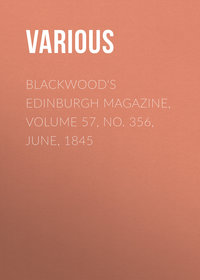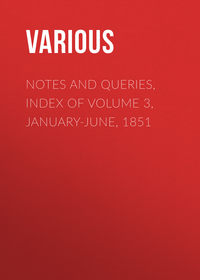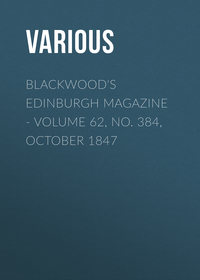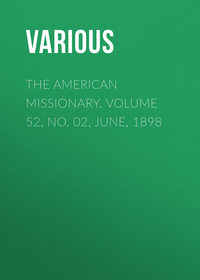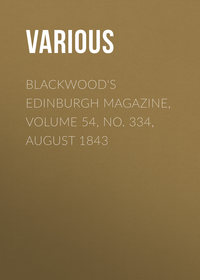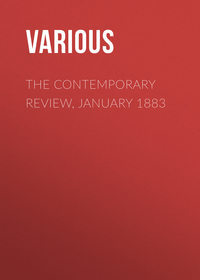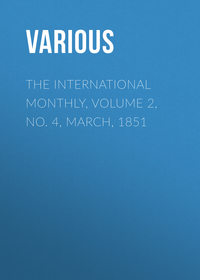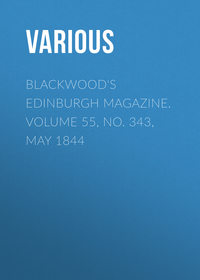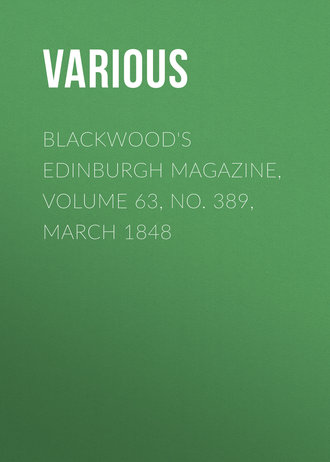 полная версия
полная версияBlackwood's Edinburgh Magazine, Volume 63, No. 389, March 1848
And here the reader doubtless expects, if not a full description of the ceremony of canonisation, at least an accurate detail of the various steps of the process by which it was effected; but, as we have stated above, the incubation had been completed six weeks before in a private Eccaleiobion, and the pageant to-day was merely to give publicity to the metamorphosis – to read in, and to enrol among the saints the Beata Francesca. As we cannot give a particular account of the funzione, we give a general one of all masses: —
High mass! The stall'd and banner'd quire —White canons – priests in quaint attire —The unfamiliar prayer:The fumes that practised hands dispense,The tinkling bells, the jingling pence,The tax'd but welcome chair:The beams from ruby panes that glow,Of rhythmal chant the ebb and flow:The organ, that from boundless storesIts trembling inspiration poursO'er all the sons of care;Now joyous as the festal lyre,When torch and song and wine inspire;Now tender as Cremona's shell,When hush'd orchestras own the spellAnd watch the ductile bow —Now rolling from its thunder-cloud,Dark peals o'er that retiring crowd,And now has ceased to blow.CRIMES AND REMARKABLE TRIALS IN SCOTLAND
INCIDENTS OF THE EARLIER REIGNS – AN INQUIRY INTO THE CHARACTER OF MACBETHThe sunshine and the green leaves embrace not all that we should know of physical nature. Storm and darkness have their signs, which we do well to study; and in the tempests of the tropics, or the long winter darkness of the poles, we have types of the character of different sections of the globe, more marked than the varying warmth of the sun, or the character of the vegetation – but not perhaps so pleasing. Even so, the storm and darkness of the human soul – the criminal nature of man, provide their peculiar food for the thinker and inquirer. The annals of virtue have their own elevations and delights; but those of vice are no more to be passed over than the dark and stormy hours in the history of each revolution round the sun. "While some affect the sun, and some the shade," there may even be those whose most deeply cherished associations are with these unlit hours – who prefer the night thoughts to the day dreams. But to all, the crimes peculiar to different nations are a large part of the knowledge which man may profitably have of his race. In the history of its great criminals, a nation's character is drawn, as it were, colossally, with the broadest brush, and in the deepest shadows. National virtues have delicate and subtle tints, and exquisitely minute shadings, inviting to a nearer view – like Carlo Dolci's Madonnas, or Constable's forest landscapes: the crimes of a nation present the character of its people, as they rise from the dead in Michael Angelo's Last Judgment. The ordinary vices of men have a certain vulgar air of uniformity; but each great crime is a broad dash of the national character of the people among whom it was committed. The Cenci, and Joanna of Naples were of Italy. It was in Holland that two great and virtuous statesmen were torn to pieces by the mob. The dirk, long buried beyond the Grampians, has re-appeared across the Atlantic in the shape of the bowie-knife. The country of Woldemar and the sorrows of Werther produced that most amiable and sentimental of murderesses, Madame Zwanziger, who loved and was beloved wherever she went; so sensitive, so sympathising, so sedulous, so studious of the wants of those by whom she was surrounded, so disinterestedly patient; she had but one peculiarity to distinguish her from an angel of light – it was an unfortunate propensity to poison people! We read in the Causes Célèbres, of a Bluebeard who slew a succession of wives by tickling them till they died in convulsions; and at once we are reminded of that populace who are said to partake of the natures of the ape and the tiger. The people who, for more centuries than are included in the events of European history, have been resolved into the mysterious classification of castes, produced those equally mysterious criminals the Thugs, for whose deeds our so utterly different habits and ideas are quite incapable of finding or conceiving a motive. Our own country produced the assassinations of Rizzio, Regent Murray, and Archbishop Sharpe – all pregnant with marked national characteristics; aristocratic pride, revenge of wrong, and fanatical fury. We propose to offer for the amusement or instruction – which he pleases – of our reader, a few more records of Scottish crimes, not probably all so conspicuously known to the general reader as the three we have just alluded to, yet not, we trust, without something to commend them to notice, as characteristic of the country and the age in which they were respectively enacted.
The raw materials from which we propose to work out our little groups, are the records of our criminal trials; and yet we feel an insuperable inclination to begin with a name not certainly unknown, yet not to be found in the proceedings of the Court of Justiciary – Macbeth, King of Scotland. Perhaps we might consider it a sufficient reason for holding his case equivalent to a trial, that before a tribunal called the Public Opinion, he has been tried, and that at the instance of such a public prosecutor as never opened his lips in any court of law – one whose accusation has carried a conviction deep into the very heart of literature, whence no archæological evidence, and no critical pleading will ever eradicate it. Nor would we desire to touch it: let Macbeth the murderer remain to all time the most powerful picture of temptation, leading its victim through crime into the hideous shadows of remorse, that human pen has ever drawn. But there was an actual prose Macbeth, as different from the ideal as the canvass bought by Raphael of some respectable dealer in the soft line, was from the Transfiguration which he afterwards painted on it. With him, being but a simple historical king, we may take liberties; and the liberty we propose to take on the present occasion is that of vindicating his character. Vindications are fashionable; and since Catiline and Machiavelli, Richard III., and Philip II. have been vindicated, why not Macbeth? We shall say 'tis our humour to whiten him, and no man can say it is a criminal or mischievous one.
The main question is, did Macbeth murder Duncan? It was an older story in Shakspeare's time than the murder of Darnley is now, and he may have taken a false view of it. We shall approach the question by an inquiry who Duncan and Macbeth were, and in what relation they stood to each other. About the end of the eleventh century, there reigned in Scotland a king called Kenneth III. Like all the other Scottish monarchs of the period, the chroniclers have given him his own peculiar tragic history, in this wise: he was induced to poison the young prince Malcolm Duff, who might possibly show a title to the throne enabling him to compete with Kenneth's own offspring. This troubled his conscience. He "ever dreaded in his mind," in the expressive words of old Bellenden, that it "should come some time to light: and was so full of suspicion, that he believed when any man rounded to his fellow, that they spake evil of him; for it is given by nature to ilk creature, when he is guilty of any horrible crime, by impulsion of his conscience, to interpret every thing that he sees to some terror of himself." He was one night appalled by a terrific vision, and next morning making his confession, he was sentenced to a pilgrimage to the tomb of St Palladius at Fordun. When the pilgrimage was over, he was invited to partake of the hospitalities of a lady named Fenella – a very neat name for a romance – at her fortalice of Fettercairn. In the civil conflicts or the administration of justice during his reign, some of the relations of this lady had been slain; among the rest her son. Having got the king into her toils, she resolved to put him to death; and the method which the chroniclers make her adopt, shows a superfluous ingenuity ridiculous enough to strip a murder of all its horrors. Kenneth was taken to see a tower of the castle "quhilk was theeket with copper, and hewn with maist subtle mouldry of sundry flowers and imageries, the werk so curious, that it exceeded all the stuff thereof." In the middle of this tower stood an image of Kenneth himself, in brass, holding in his hand a golden apple studded with costly gems. "That image," said the lady, "is set up in honour of thee, to show the world how much I honour my king; the precious apple is intended for a gift for the king, who will honour his poor subject by taking it from the hand of the image." Now matters were so arranged, that the removal of the apple caused certain springs to touch the triggers of a series of bent cross-bows pointed to the spot, and so, when the unsuspecting monarch went to take the gift, a whole sheaf of arrows penetrated to his heart. On the death of this king, though he left a son called Malcolm, the succession went to a rival line. His immediate successor was Constantine, who was killed by another Kenneth, called IV., who in his turn was killed by Malcolm, who thus regained the throne his father had filled. "The gracious Duncan" was the son of a daughter of this Malcolm. His father, strangely enough, appears to have been a priest; he is called in the old dry chronicles, which are the only ones to be depended on, Duncan the son of Trini, or Trivi, abbot of Dunkeld. Now the Kenneth IV. of the rival line, who had been slain by Duncan's grandfather, left behind him a son, and that son left a daughter, whose name was Gruach, and in whom the reader, though certainly in an unusual shape, must welcome Lady Macbeth herself. There being thus two rival races, alternately seizing the throne: while Duncan was the son of a daughter of one king, she was the daughter of the son of another. This gave her no contemptible title to the throne, and when she married Macbeth, or Machaboedth, as he is called by the chroniclers, she had a husband who, possessing the almost independent principality of Ross, might be able to fight her battles. It is somewhat remarkable that, in an ecclesiastical record still preserved, in which a royal grant is made to a religious house, dedicated to St Servanus, Macbeth's wife appears along with himself, as granter of the deed; and they are called, "Machabet filius Finlach, et Gruach filia Bodhae – Rex et Regina Scotorum;"12 an equal juxtaposition, only to be accounted for by the supposition that Macbeth was king in right of his wife. As to Macbeth himself, his origin, save in the supernatural legend we shall hereafter notice, appears not to have been known; but Fordun seems to intimate, that he was a descendant of that same Fenella who had so curiously murdered Duncan's great-grandfather. If we were disposed, indeed, to take a proper antiquarian partisanship of the one dynasty against the other, we might speak of Duncan as a treacherous usurper, and Lady Macbeth as an injured and insulted queen, whose cause is heroically adopted and vindicated by a true knight, who, while redressing her wrongs, wins her heart and hand.
Let us now look to the manner in which the death of Duncan is spoken of by the most ancient authorities. Old Andrew Wyntoun, Prior of St Serfs on Lochleven, who has never yet, to our great wonder, been upheld as one of the greatest poets of his own or any other age, – perhaps we may undertake the task some day, let our readers judge by the extracts on the present occasion with what prospect of success: – Wyntoun narrates the event with the true simplicity of genius, in these two lines: —
"He murthrified him in Elgyne,His Kynrik he usurped syne."This is distinct enough, in all truth: there is no ambiguity, or room for critical doubt; nor is his fellow annalist, Fordun, less distinct, for he speaks of the slain monarch as occisus scelere. But these chroniclers wrote between three and four centuries after the event they commemorate, standing chronologically almost as near our own day as Macbeth's; and when we look into those far older, if not contemporary, annals, which narrate successive events in the briefest possible shape, we find that they contain nothing to indicate that Duncan's death took place in any more atrocious manner than the multitudinous slaughters of kings, with which their narratives are often as crowded as a Peninsular campaign gazette with killed officers. Thus, the register of the Priory of St Andrews simply states, that Duncan interfectus est. It is true that the Latin language is deficient in any word to express murder as distinguished from other kinds of slaughter. Trucido is the verb we have been accustomed to associate most nearly with the idea of assassination; but in one of the most circumspect and prosaic of the old annals, that of Tighernac, this very word is applied to the death of Macbeth himself. Blackstone notices the circumstance that the English lawyers had to coin, for their own special use, the substantive murdrum and the verb murdrare; equally creditable to their good taste in Latinity and to the social condition of their country. In fact, the Romans looked upon death, in any form, as so bad a business, that they cared little for making nice distinctions about the motive that had occasioned it, or the manner in which it was effected; and it was a condition so generally disliked, that, if any man was absurd enough voluntarily to place himself in it, neither the law nor public opinion troubled itself to express disapproval, either by driving a stake through the body or in any other way. Undoubtedly there were justifiable slaughters and unjustifiable; but the practice of single combat had not arisen to draw a strong and distinct line between death in a fair tournament or duel, and secret assassination. A recollection that this was also the social state of Scotland in the days of Macbeth, will help us far better towards the truth than a criticism on the ambiguous Latin words. It was between that age and the period of Wyntoun and Fordun that single-combat chivalry and the laws of honour had grown up; so, while the older chroniclers had simply to say that the man was killed, without troubling themselves about the manner, those of later date were moved to divide the deaths into two departments – the killed in combat and the murdered. More, probably, by chance than design, the fate of Duncan was put into the latter category; and then a super-structure of particulars was raised upon it – for it must be observed, that the romantic incidents of the slaughter were added at a still later period than that of Fordun or Wyntoun – by Boece and Hollinshed. Here, then, is our case, as lawyers say: Macbeth, in right of his wife, was a claimant of the crown. He kills the existing holder; but there is nothing in the older accounts of the affair to show that he did so otherwise than in the fair course of war. It was what the old civilians would have called a casus belli, – an expression which, by the way, we find some accomplished editors using as the Latin for a justification of war. The murder is found only in the later chronicles, which, in all parts of their narrative, have covered their more sober predecessors with a coating of fabulous details like the stalactites of a dripping cave. However the real fact may have stood, we have no statement of Macbeth having murdered Duncan until between three and four centuries after the event. Why, – the case looks vastly better than we thought it did when we began with it; we have some thoughts of believing our own theory, which is more than ever we knew a historical critic do, within the range of our personal observation.
Having so disposed of this question, we are inclined to amuse our readers with some further notices – real and unreal – about Macbeth. Wyntoun gives us a strange wild legend of his supernatural parentage, beginning
"Bot, as we fynd be some stories,Gotten he was in fairly wys;His modyr to woods made oft repaire,For the delyte of halesome air;Swa sho passed upon a day'Til a wood her for to play,Scho met of cas with a fair man(Never nane so fair as sho thought thanBefore than had sho seen with sight)Of beauty pleasand, and of hychtProportioned wele in all measure,Of limb and lyth a fair figure."Such is the description of the putative father of Macbeth. In the sententious explanation of Wyntoun, who scorned expletives, "he the devil was;" and so he told the wandering damsel —
"And bade her nought fleyed to be of that,But said that her son should beA man of great state and bounty;And na man sould be born of wifeOf power to reve him of his life.And of that deed in taknyng,He gave his leman then a ring,And bade her that sho sould keep that wele,And hald for his love that jewel."Wyntoun's melodious verses were lying in a dusty parchment manuscript when Shakspeare wrote; we know not if he had access to the volume, nor have we any strong reason for presuming that he would have perused it if he had. It would be too adventurous to predict whether, knowing the legend, he would have considered any reference to it as consistent with the character of his drama; but it is curious to observe, that the tale appears to have been in the eye of Sir Walter Scott, when he wrote the history of Brian the Hermit, in the Lady of the Lake, beginning —
"Of Brian's birth strange tales were told:His mother watch'd a midnight fold."We shall now indulge our readers with a glance at a totally different feature in the career of Macbeth. It appears that he was a very able financier. We presume that he was his own First Lord of the Treasury and Chancellor of the Exchequer: yet in his days there was no pressure on the money-market; there was no drain of gold; there was no restriction of issue; no great houses suspended payment; there were no rumours of turns-out and distress in the manufacturing districts; there was no Highland destitution. Our proof of this position lies in two lines of our illustrious poet Wyntoun, which contain as much as a smaller genius could have crowded into a volume on "The state and progress of Scotland during the reign of Macbeth; with an account of the arts, industry, and manufactures of the country; returns of the exports and imports, and of the goods entered for home consumption, with the annual gross and net revenue from customs and excise, post-office, assessed taxes, hereditary revenue, and other miscellaneous sources, during that reign: dedicated, by permission, to the Statistical Society." Wyntoun's simple statement is —
"All his time was great plenté,Abundant both by land and sea."What more is necessary? It is true, that on another occasion we have repudiated Wyntoun as an authority; but it is the privilege of the antiquarian speculator to found on an author when he is right, and repudiate him when he is wrong.
We now come to a subject on which really, jocularity apart, we stand upon firm and secure ground – the spot where Macbeth fell. All the chroniclers with one voice state that it was at a place called Lunfanan. Even Raphael Hollinshed, whose version, it is universally admitted, was the one perused by Shakspeare, – after he tells how the beleaguered fugitive beheld the miraculous forest with which his doom was involved approaching him, continues to say – "Nevertheless, he brought his men in order of battle, and exhorted them to do valiantly: howbeit, his enemies had scarcely cast from them their boughs, when Macbeth, perceiving their numbers, betook him straight to flight, whom Macduff pursued with great hatred, even till he came to Lunfannane." Perhaps Shakspeare, not knowing precisely where Lunfanan lay, supposed that it was some spot close to Dunsinane, and did not wish to burden his action with the particularity of an unimportant movement. Lunfanan is, however, north of the Dee, and distant full fifty miles in a straight line from Dunsinane, the rough mountains of the Braes of Angus lying between the two places; so that the two parties must have had a pretty long running fight, and Macbeth stood out even harder game than he has generally credit for. Our favourite poet describes the chase across the broad valley of Strathmore, through the rocky glens of Clova, over the Isla and the Esk, down through the hoary forest of Glentanner, across the raging Dee, and up again through mountain and forest, in this sententious and emphatic couplet,
"And our the Month they chaised him than'Till the wood of Lunfanan."When the victory was completed, we are told that they cut off his head, and bore it to King Malcolm at Kincardine – a pleasant village on the banks of the Dee, about ten miles from Lunfanan.
This same Lunfanan is a spot which it requires particular taste to love, and yet we have perambulated it not without interest. The Chroniclers speak of it as a forest, but the highest elevations are now generally bare of trees, save where in a few sheltered hollows the birches cling to the rocks. The hills are of considerable height, but round and bare, with few precipices, and little character of outline; but the glens between the hills are sheltered and well cultivated, each is enlivened by a small stream, and still more enlivened by the scanty population seeking the shelter of the recesses of the glen, and making it populous amid the waste. But we shall afford a better description than our own, in a few lines from "The Fortunate Shepherdess," by a poet who lived in a glen not far distant – Alexander Ross. It will be admitted, by the way, that our poetical quotations to-day are not of a hackneyed kind, whatever other censure they may incur.
"The water keely on a level sleed,Wi' little din, but couthy what it made:On ilka side the trees grew thick and strang,And wi' the birds they a' were in a sang;On ev'ry side, a full bow-shot and mair,The green was even, gowany, and fair;With easy sklent, on ev'ry hand, the braes,To right well up, wi' scattered busses raise,Wi' goats and sheep aboon, and ky below,The bonny braes a' in a swarm did go."Occasionally, when the new earth is turned up, strange uncouth warlike instruments are found in this district – remnants of ancient strife, so unlike any weapons recorded in the genuine history of the military art, that it were hard to say whether they belong to the age of Macbeth, or to unknown anterior centuries. Flint arrow-heads, stone hammers and axes, – such is their general character, though we have also seen among these mysterious discoveries, such a thing as a long flat mass of decomposed iron, which may have once been the blade of a dagger, or short sword. Here the knowing reader, who has been induced, on the field of Waterloo, to purchase a ball-perforated cuirass and helmet, which he afterwards discovers to have been made at a manufactory of Waterloo relics, will curl his lip in scorn; but he is wrong. Lunfanan is no relic-collecting district. We question if the inhabitants ever made a shilling of any one, the present company excepted, by the military stores discovered by them when ploughing their tough peat soil. We did not require there to practise the method of self-defence which we adopted on a visit to the field of Waterloo; and by the way – as we are inclined to recommend it strongly to our friends, as an effectual preservative from the main annoyance to which the hero-worshipper is subjected – we may here describe our method. On hiring our guide, we desired him to procure for us a fragment of an old kettle. Carrying this conspicuously in our hard, to each band of relic-sellers who came up, we stated that we were in the trade ourselves, that we had just acquired a very valuable article, and were willing to part with it at a moderate price. The cuirassiers did not look more ridiculous, when they attempted to storm the squares, than our assailants, when we fortified ourselves behind this piece of defensive armour. But to return to Lunfanan.
In one of the narrow glens, near the old parish-church, there is an oblong solid turf bank, or mound, of considerable height, and regular construction, as clean and sharp in its outline as the glacis of a modern fortification. A neighbouring stream has been diverted round it, or rather the waters have been divided and distributed on either side, so as to surround it with a fosse. This curious antiquity is called "the Peel Bog," or Castle Bog. "The course," says the author of the statistical account of the parish, "by which the water was conveyed from the burn of Lunphanan may still be traced; the measure of the circumvallation by which the water was confined may still be made; the situation of the drawbridge is still discernible; the path leading from the fosse to the top of the mound may still be trodden; and the sluice by which the water issued from the moat, was laid bare by the flood of 1829."13 Even the sceptical Lord Hailes ventured to associate Macbeth's name with the spot; "as no remains of buildings," he says, "are to be seen, it is probable that the fortress was composed of timber and sod. In this solitary place, we may conjecture that Macbeth sought an asylum." At some distance from the Peel Bog, a low thin rampart of earth and stone encircles the summit of a conical hill; it is an inferior specimen of the old British hill-fort, well known both in Scotland and the north of England. But on the brow of one of the hills, there is a still more emphatic memorial of the monarch's fate. There a heap of gray stones, considerably larger than many others surrounding it, is still called, and is represented in the county maps as Cairn Beth. We must admit that, were it in a tourist's district, or were it the spot which popular literature, of any kind had marked as the grave of Macbeth, this would be suspicious. But no tourist's footstep seeks the quiet uninviting wilds of Lunfanan. There is no railway line, not even a stage-coach communication, between it and the world. You have but to see the rough, primitive, granitic air of the Lunfananers assembled at the parish church, to know that they are incapable of any imposition. Legends we always distrust, especially when they are connected with any spot sanctified by poetry. At Dunsinane, we believe, some vestiges are shown as marking the spot of the usurper's death, the "genuine" spot, "all others being spurious imitations;" but we suspect this legend is not even so old as Shakspeare's day, that it is no older than the revival of Shakspearean literature, and the rise of a general public interest in the spots illuminated by his genius.14 For more than one castle, Cawdor included, has the merit been claimed of being the identical edifice in which Duncan was slain, and undoubted four-posted bedsteads have been shown in actual existence to put scepticism to scorn. But any popular association of the actual events of Macbeth's career with quiet remote Lunfanan has been barred by the silence of Shakspeare, and the unwillingness of topographical critics to break the spell of the accepted localities. Though legends spring up like rumours, with a breath, the names of places which they have received from historical incidents are generally of long standing, and, indeed, a large proportion of the lowlands of Scotland is full of places which to this day bear Celtic names, given them by tribes who cannot have inhabited the districts for a thousand years at least. The old chroniclers, without exception, lay Macbeth's death in Lunfanan; the people of the spot, who never read these chronicles, and never, perhaps, heard of Macbeth, or if they did, heard the popular account of his death in Dunsinane, call a certain monumental tumulus Cairn Beth – this, we think, is very nearly conclusive.15 And yet, sitting on that Cairn, with the fresh breeze blowing round one, and the blue heavens above, and the blooming heather-bells around, or reclining on the smooth green turf of the Peel Bog, on a summer day, with the sun shining hot upon the hills, and the babbling brook singing its "quiet tune," it is not easy to associate the spot with that history of blood and horror, or to feel that its features are ancient, or that they ever were connected with warfare. In the gloomy, galleries of Glammis or Cawdor, with their grim old portraits, their armour, their secret staircases, their mysterious hidden chambers, and iron hooks in the wall – the idea of the haggard murderer, and all the associations of his deeds and his remorse creep more vividly on that imaginative conscience, which more or less makes cowards of us all in such places. Yet the history of the arts tells us that not one stone of these edifices, ancient though they be, can have stood upon another till the history of Macbeth was as old as that of Queen Mary is now. Why, then, should they retain their hold on us? They are contemporary with Shakspeare's Macbeth, though not with the historians', and are the style of edifice in which he cast his tragedy. It must be a feudal stronghold, heavily arched, buttressed, fortified, and gloomy, – where the lady in a vaulted half-lighted chamber may say:


